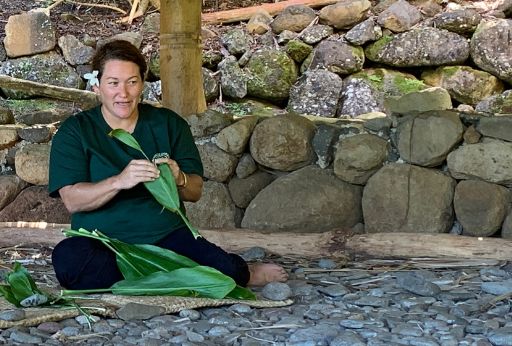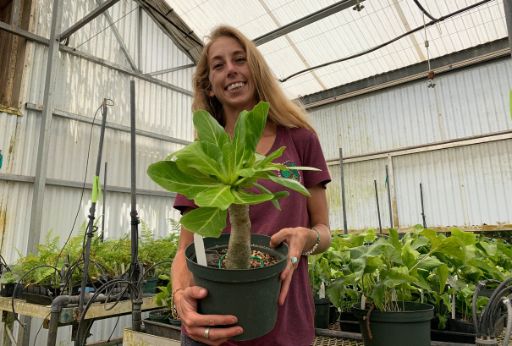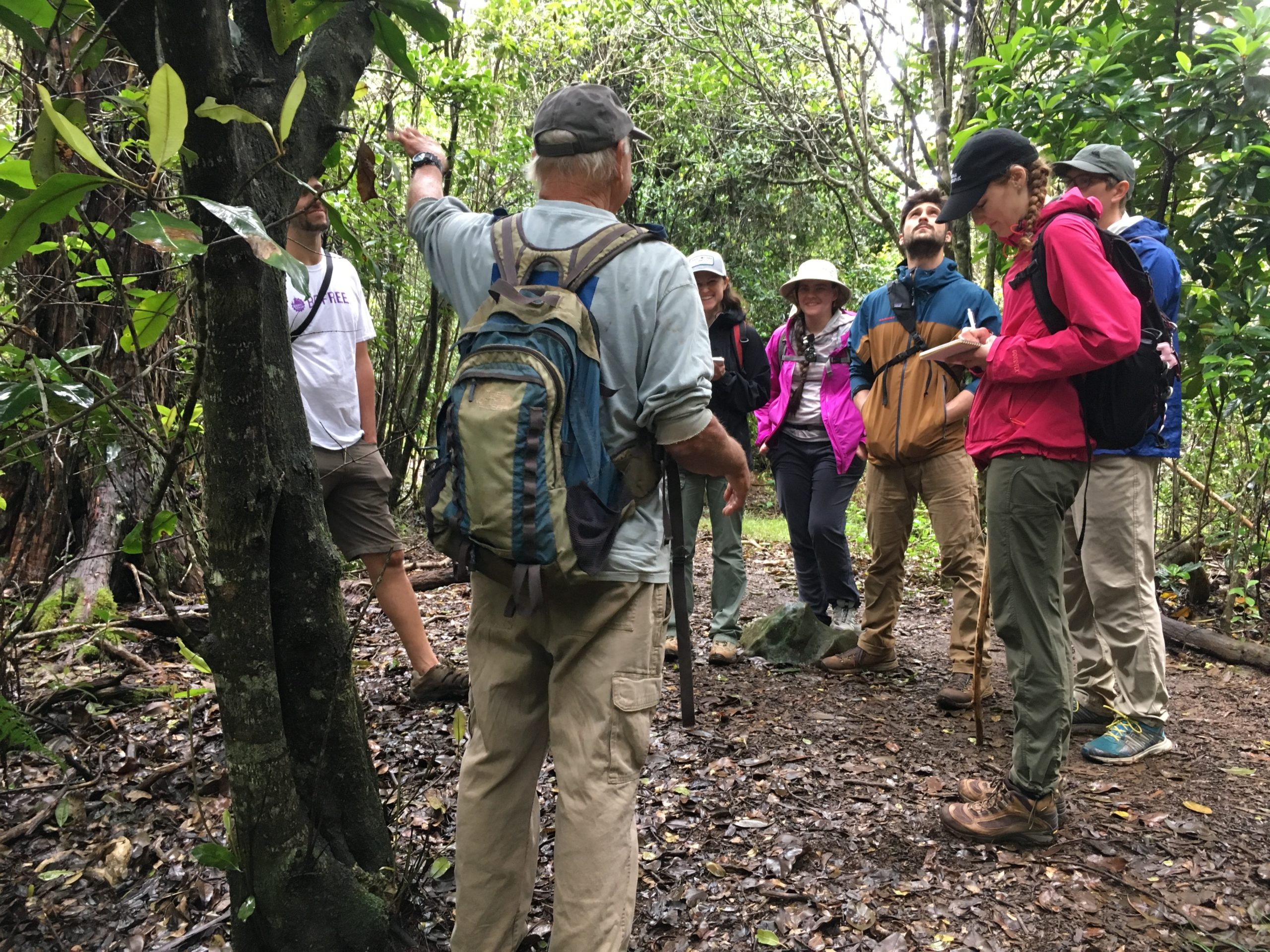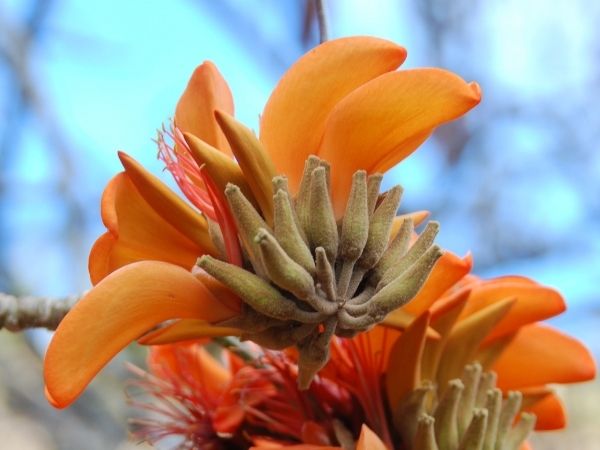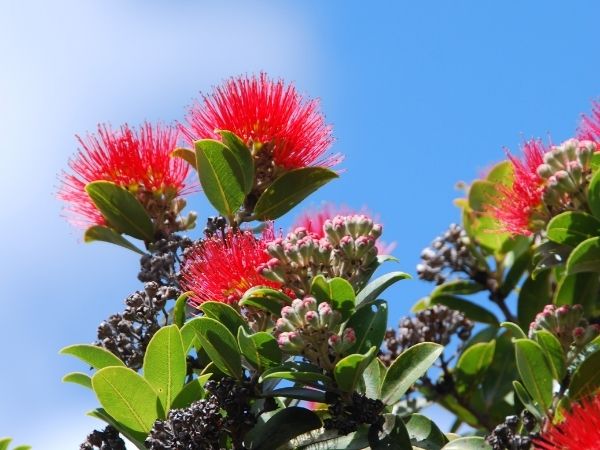Tropical Plant Database - Plant Details
Cattleya hybrid
Click on any heading above to view more information about this plant
Conservation Status
- IUCN: Not Evaluated
- USFWS: None
Family: ORCHIDACEAE
Genus: Cattleya
Species: hybrid
Genus: Cattleya
Species: hybrid
Cattleya orchids have a low-growing habit with a slender, creeping stem that produce only a few, thick leaves. The leaves are ovate, meaning they are widest at the base and gradually tapering towards the apex, and are slightly folded along the midrib. The flowers are borne terminally on the stem in clusters of 4-5 flowers. Cattleya flowers are 3-parted, and in this species all of the floral parts including the sepals (outer petal-like structures) and petals (inner series of petal-like structures) are white. All orchid flowers have one of the petals highly modified to form the lip or labellum. The labellum is tubular in this hybrid and is fringed on the edges, and it surrounds the pollen and ovule producing structures in the flower. Cattleya flowers have only a single fertile anther (pollen producing structure), however, that single anther will produce thousands of pollen grains. The pollen grains are connected by minute strands to form a mass of pollen that is called a pollinium.
(Neal, M.C. 1965. In Gardens of Hawai‘i. Bishop Museum Press, Honolulu, HI.)
(Neal, M.C. 1965. In Gardens of Hawai‘i. Bishop Museum Press, Honolulu, HI.)
This hybrid Cattleya was produced by Benjamin Kodama, a Hawaiian local and owner of the Kodama Orchid Nursery on O‘ahu. Kodama has cultivated thousands of hybrid orchid species during his breeding career and is credited with an Award of Distinction, the top honor bestowed by the Interantional Phalaenopsis Alliance for his contribution to Orchid cultivation. The Benjamin Kodama Award recognizes the contribution of Benjamin Kodama and his family to Dendrobium orchid breeding and is presented every year by the American Orchid Society to the Orchid grower with the most outstanding Dendrobium Alliance cultivar.
(Bolce, J. (ed.), 2005. A Treasure in British Columbia. The Journal of the Canadian Orchid Congress 17(2).)
(Wood, P. D. 2005. The Great Seduction. Hana Hou, 8(2).)
(Bolce, J. (ed.), 2005. A Treasure in British Columbia. The Journal of the Canadian Orchid Congress 17(2).)
(Wood, P. D. 2005. The Great Seduction. Hana Hou, 8(2).)
Cattleya contains around 50 naturally occurring species and has a center of diversity in Brazil which has over 27 native species. The remaining species are native to Columbia, Central America and Mexico.
(Smidt, E.C., V. Silva-Pereira, and E. L. Borba. 2006. Reproductive biology of two Cattleya (Orchidaceae) species endemic to north-eastern Brazil. Plant Species Biology 21: 85-91.)
(Smidt, E.C., V. Silva-Pereira, and E. L. Borba. 2006. Reproductive biology of two Cattleya (Orchidaceae) species endemic to north-eastern Brazil. Plant Species Biology 21: 85-91.)
The orchid, Vanilla planifolia, is the source of vanilla. Vanilla is obtained from the fruit of this species and therefore hand pollination is carried out to ensure that fertilization occurs so that the fruit develop. The fruit undergo a lengthy processing involving air drying and fermentation in order to bring out the aroma and flavor of the vanilla.
(Simpson, B. B. and M.C. Ogorzaly. 2001. Economic Botany. McGraw Hill, Boston, MA.)
(Simpson, B. B. and M.C. Ogorzaly. 2001. Economic Botany. McGraw Hill, Boston, MA.)
Cattleyas are susceptible to infestation by the wasp species Eurytoma orchidearum which is known by the common name cattleya fly. This species is native to tropical Central and South America and was first documented in Hawai‘i in Honolulu in 1914. This insect was subsequently eradicated but was re-introduced in 1948 and is now on Oahu, Hawai‘i, Kaua‘i and Lana‘i. The adult fly lays eggs into young plant tissue at the base of a plant, and the emerging larvae feed on the plant tissue producing cavities in the plant structures in which larvae are found. Infested plants contain deformed tissues and usually fail to flower.
(Tenbrink, V.L. and A.H. Hara. Cattleya Fly: Eurytoma orchidearum (Westwood). Beaumont Research Center, Hilo, Hawaii. Accessed 6/16/2007. http://www.extento.hawaii.edu/Kbase/crop/Type/e_orchid.htm)
(Tenbrink, V.L. and A.H. Hara. Cattleya Fly: Eurytoma orchidearum (Westwood). Beaumont Research Center, Hilo, Hawaii. Accessed 6/16/2007. http://www.extento.hawaii.edu/Kbase/crop/Type/e_orchid.htm)
Another Cattleya species, Cattleya skinneri, known by the common name Guaria morada, is the national flower of Costa Rica.
.svg)





